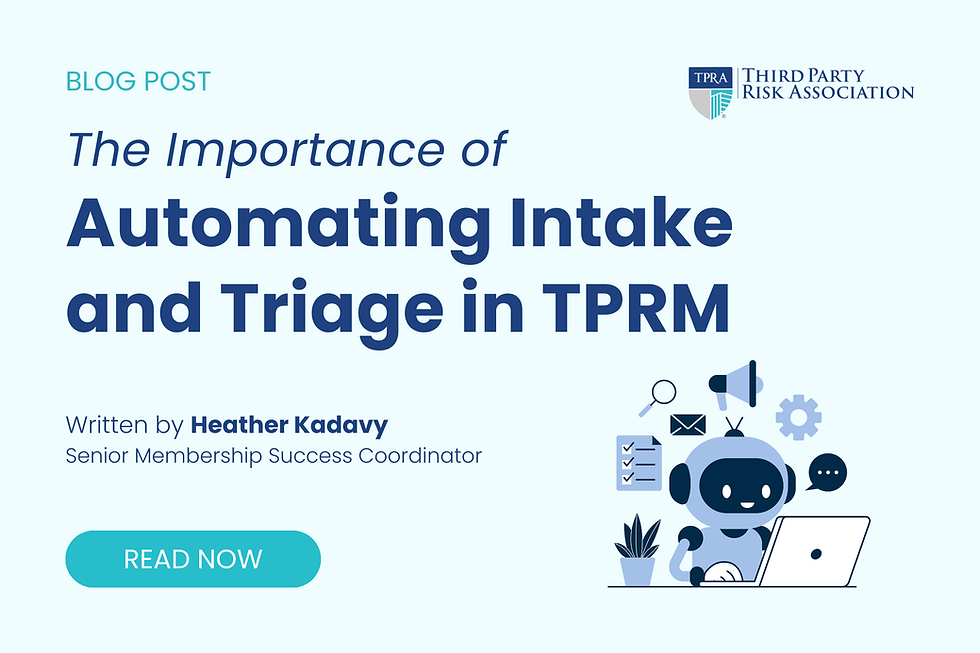Why Vendor Offboarding Is Riskier Than You Think and How Automation Can Help
- Oct 20
- 4 min read

When a vendor relationship ends, the risk doesn’t.
Too often, vendor offboarding is treated as an afterthought, left to chance, split between departments, or buried in a never-used checklist. The problem? An incomplete or inconsistent termination process exposes your organization to some of the highest risks in the TPRM lifecycle.
These risks include, but are not limited to, access that was never revoked, assets that were never returned, and/or data that was never deleted.
The good news: these risks are avoidable, and automation can help.
Why Offboarding Matters More Than You Think
In many organizations, onboarding gets all the attention, due diligence, approvals, kickoff meetings, and security reviews.
But what about the end of the relationship?
"You wouldn’t let an employee walk out the door without collecting their badge and shutting off system access. Why do we do it with vendors?"
Poor offboarding can lead to:
Lingering system access and potential unauthorized activity
Unreturned data or devices, especially in hybrid/cloud environments
No formal record of what actions were completed or by whom
Compliance gaps if data disposal or security controls were contractual
The Automation Opportunity
Here’s where automation can drastically improve vendor offboarding, making it faster, repeatable, and auditable.
1. Triggering the Offboarding Workflow Automatically
When a contract is marked as terminated or not renewed, the system will kick off automated offboarding activities.
It can route these activities to IT, InfoSec, Procurement, and TPRM automatically.
Tool tip: Use a trigger from your TPRM tool, GRC system, or contract lifecycle platform to launch this sequence.
2. Auto-Assigning Offboarding Tasks
Such offboarding tasks can include, but are not limited to:
Revoking system access and credentials
Collecting physical or virtual assets
Confirming data destruction or secure transfer
Archiving vendor risk files and workpapers
Tool tip: Use tools like ServiceNow, Jira, or Monday.com to assign tasks and track completion status in real time.
3. Generating & Storing Offboarding Evidence
The system can require documentation uploads or confirmations (e.g., screenshot of deprovisioned access, destruction certificates) of completed offboarding tasks
It can also store all evidence in the third party profile for audit purposes
Tool tip: Attach offboarding steps to a third party profile in your TPRM platform or centralize storage in a secure SharePoint folder.
4. Post-Termination Reviews
Set up a short internal review form to capture any final third party risks or lessons learned.
Optionally trigger a survey to business owners to assess third party performance.
Update the third party’s profile to note if the third party can be used again or if it is recommended to not do business with the third party.
Tool tip: Use Microsoft Forms or Google Forms and auto-send based on the third party status change.
Real-World Example: Offboarding Automation at a Global Fintech
A fintech company with over 1,200 third parties discovered that more than 30% of “inactive” third parties still had some form of residual access, including access to shared cloud folders and legacy single sign-on (SSO) profiles.
The organization then implemented a third party offboarding checklist built into their TPRM platform, which auto-triggered when a contract end date was reached or when a business owner marked a third party as "no longer in use."
Each task, such as deprovisioning access, collecting assets, confirming data deletion, was auto-assigned to pertinent stakeholders with deadlines and owner accountability.
Results in the first 6 months:
Reduced open-access risk by 78%
100% of offboarding steps documented and accessible for audits
Gained stronger alignment between TPRM, InfoSec, and Procurement
Getting Started: Questions to Ask
Do we have a standard offboarding checklist for third parties?
Who owns each task, and how do we know the tasks were completed?
Can we identify all third parties with system access that may still be active post-contract?
Do we store evidence of data destruction or handover?
Quick Win to Try
Start by creating a centralized third party offboarding checklist with due dates and owner fields. Even if you use Excel or a Google Form at first, link this to third party termination triggers and build consistency from there.
Then, explore how your existing tools (TPRM platform, ticketing system, workflow automation) can formalize and automate the process.
For additional information on the third party Termination process, view TPRA’s TPRM 101 Guidebook.
Author Bio

Heather Kadavy
Senior Membership Success Coordinator
Heather Kadavy joined the Third Party Risk Association (TPRA) in 2023 as the Senior Membership Success Coordinator. In recent year(s) Heather has been providing freelance TPRM consulting work to various organizations after retiring from a Nebraska financial institution after nearly 35 years where she oversaw and managed critical programs of the organization including Third Party Risk Management, Information Security,
Physical Security, Safety, Business Recovery, Financial Crimes, Model Risk Management, and Enterprise Risk Management. In her TPRM role she had oversight of over a thousand third party relationships, systems, due diligence reviews and contract management activities. She developed, facilitated, and implemented training programs for thousands of employees over the years.
Heather is a natural born connector of people and values relationship building at the cornerstone of her career. She encourages you to connect with TPRA and herself via LinkedIn to join in the "TPRM Global Conversation".



Comments